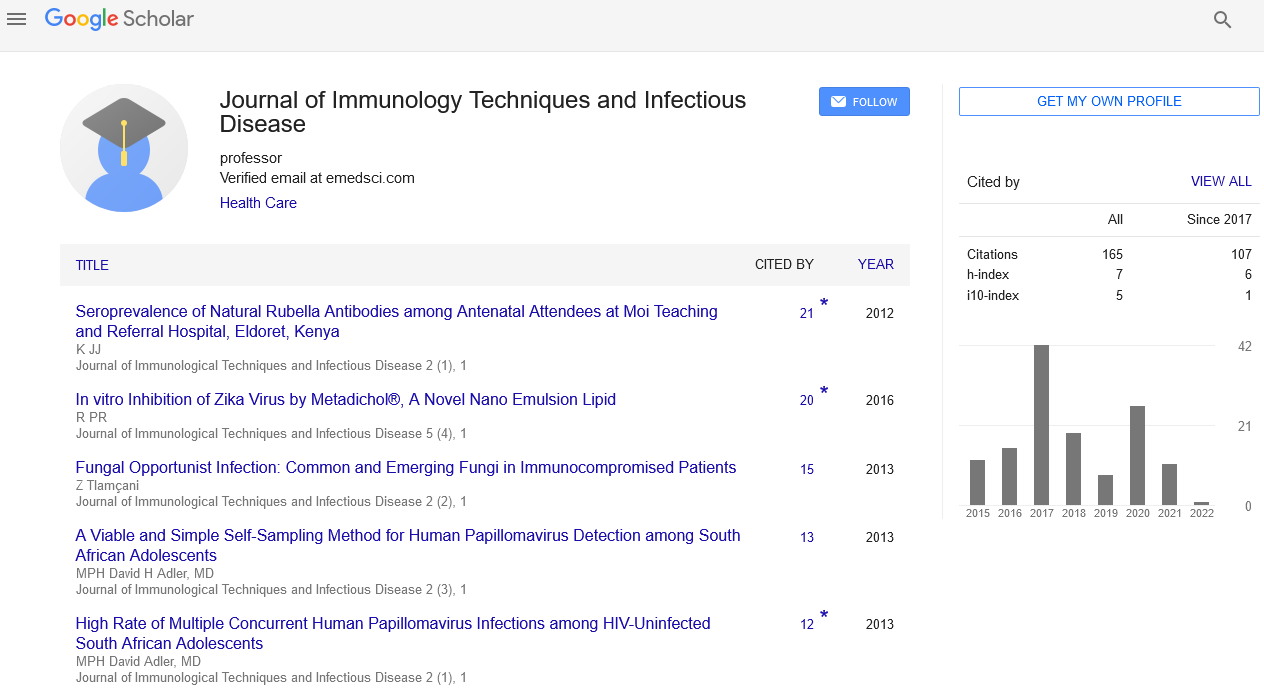Commentary, J Immunol Tech Infect Dis Vol: 12 Issue: 2
Clinical Significance of Antibodies to Red Blood Cells
Eon Chun*
1Department of Microbiology, University of Ulsan College of Medicine, Seoul, South Korea
*Corresponding Author: Eon Chun,
Department of Microbiology, University of
Ulsan College of Medicine, Seoul, South Korea
E-mail: Eonchunx@gmail.com
Received date: 29 May, 2023, Manuscript No. JIDIT-23-105441;
Editor assigned date: 31 May, 2023, PreQC No. JIDIT-23-105441 (PQ);
Reviewed date: 14 June, 2023, QC No. JIDIT-23-105441;
Revised date: 21 June, 2023, Manuscript No. JIDIT-23-105441 (R);
Published date: 28 June, 2023, DOI: 10.4172/2329-9541.1000347.
Citation: Chun E (2023) Clinical Significance of Antibodies to Red Blood Cells. J Immunol Tech Infect Dis 12:2.
Description
Antibodies to Red Blood Cells (RBCs) play a crucial role in various clinical scenarios, ranging from transfusion reactions to autoimmune hemolytic anemia. Understanding the clinical significance of these antibodies is paramount in ensuring accurate diagnosis, appropriate management, and improved patient outcomes. This aims to explore into the complexities surrounding antibodies to RBCs, exploring their classification, detection methods, and associated clinical conditions healthcare professionals can enhance their knowledge and decisionmaking abilities when encountering patients with RBC antibodyrelated complications.
RBC antibodies are classified based on their ability to cause hemolysis in the presence or absence of an external trigger. Autoantibodies are directed against self-antigens present on the individual's own RBCs, leading to Autoimmune Hemolytic Anemia (AIHA). Alloantibodies, on the other hand, are generated in response to foreign RBC antigens encountered during transfusion or pregnancy.
The most clinically significant alloantibodies are typically of the IgG class, capable of crossing the placenta and causing Hemolytic Disease of the Fetus and Newborn (HDFN). Examples include anti-D, anti-K, and anti-c. Transfusion-related alloantibodies may lead to acute or delayed hemolytic transfusion reactions, posing significant risks to patient safety.
Accurate detection and identification of RBC antibodies are essential for appropriate patient management. Laboratory techniques include the Indirect Antiglobulin Test (IAT), which detects the presence of antibodies in the patient's serum or plasma. This test involves incubating the patient's cells with commercially prepared reagent RBCs that express specific antigens. If antibodies are present, they will bind to the antigen on the reagent cells, which can be detected using anti-human globulin reagents. Additional techniques such as the Direct Antiglobulin Test (DAT) and antibody panels are used to further characterize and identify specific antibodies. Emerging technologies, such as molecular typing methods and genotyping platforms, have improved the precision and speed of antibody detection and identification. These advancements aid in detecting weak antibodies, resolving complex antibody profiles, and predicting the risk of HDFN. Molecular methods, such as Polymerase Chain Reaction (PCR), facilitate the identification of fetal RBC genotypes to guide appropriate management during pregnancy.
Transfusion reactions
Alloantibodies can cause adverse transfusion reactions, varying from mild febrile reactions to life-threatening acute hemolytic reactions. Pre-transfusion testing, including antibody screening and cross matching, is crucial to match donor RBCs with recipient antibodies and prevent hemolytic transfusion reactions. Special care must be taken in patients with a history of multiple transfusions or previous antibodies to avoid complications.
Hemolytic Disease of the Fetus and Newborn (HDFN)
Maternal alloantibodies can cross the placenta and target fetal RBCs, resulting in HDFN. Rhesus (Rh) D incompatibility is the most common cause, but other blood group antigens, such as Rh c, Rh E, and Kell, can also lead to HDFN. Routine prenatal screening and administration of Rh immune globulin (RhIg) have significantly reduced the incidence and severity of HDFN.
Autoimmune Hemolytic Anemia (AIHA)
AIHA occurs when autoantibodies target an individual's own RBCs, leading to their premature destruction. It can be classified into Warm Autoimmune Hemolytic anemia (wAIHA) and Cold Agglutinin Disease (CAD). Identifying the underlying cause and providing appropriate immunosuppressive therapy are crucial in managing AIHA.
Transfusion support in hematology/oncology
Patients with hematologic malignancies or undergoing hematopoietic stem cell transplantation often require frequent transfusions. The presence of alloantibodies can complicate transfusion support, necessitating careful selection of compatible blood products and monitoring for potential transfusion reactions.
Conclusion
Antibodies to red blood cells hold significant clinical implications, ranging from transfusion reactions to autoimmune hemolytic anemia and HDFN. Proper detection and identification methods, along with an understanding of associated clinical conditions, are vital for accurate diagnosis and optimal patient care. Advancements in laboratory techniques and emerging technologies have greatly enhanced our ability to detect and manage RBC antibodies. By staying abreast of these advancements and continually updating our knowledge, healthcare professionals can ensure improved patient outcomes and minimize the risks associated with antibodies to red blood cells.
 Spanish
Spanish  Chinese
Chinese  Russian
Russian  German
German  French
French  Japanese
Japanese  Portuguese
Portuguese  Hindi
Hindi 
